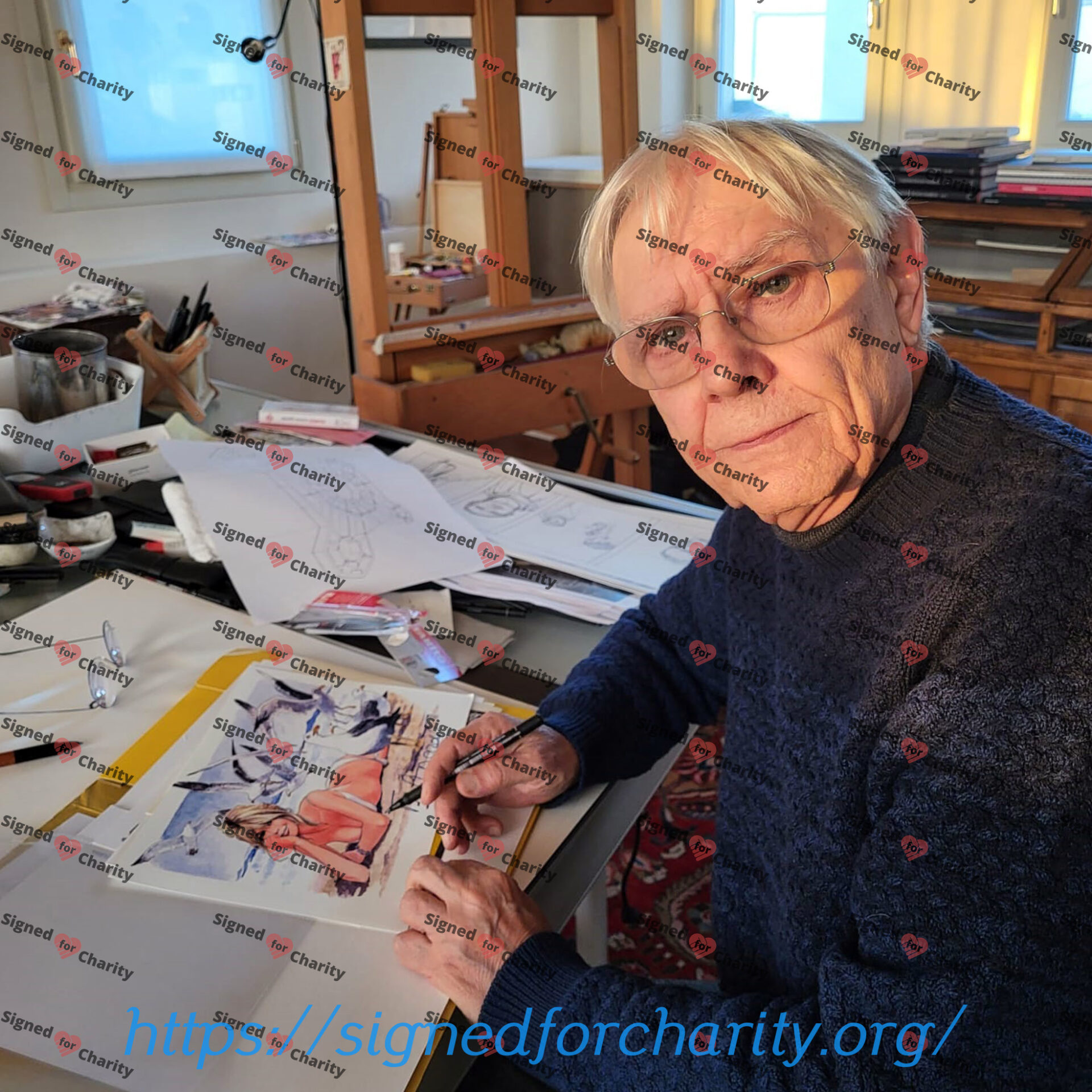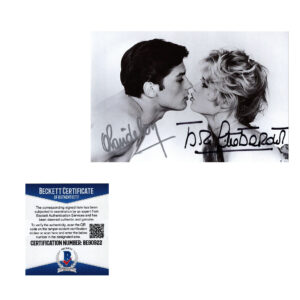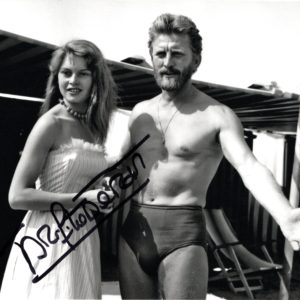Description
BRIGITTE BARDOT BIOGRAPHY :
Brigitte Anne-Marie Bardot (born 28 September 1934), often referred to by her initials B.B., is a French animal rights activist and former actress and singer. Famous for portraying sexually emancipated personae with hedonistic lifestyles, she was one of the best known sex symbols of the late 1950s and 1960s. Although she withdrew from the entertainment industry in 1973, she remains a major popular culture icon. Born and raised in Paris, Bardot was an aspiring ballerina in her early life. She started her acting career in 1952. She achieved international recognition in 1957 for her role in And God Created Woman (1956), and also caught the attention of French intellectuals. She was the subject of Simone de Beauvoir’s 1959 essay The Lolita Syndrome, which described her as a “locomotive of women’s history” and built upon existentialist themes to declare her the first and most liberated woman of post-war France. Bardot later starred in Jean-Luc Godard’s film Le Mépris (1963). For her role in Louis Malle’s film Viva Maria! (1965) she was nominated for the BAFTA Award for Best Foreign Actress. Bardot retired from the entertainment industry in 1973. She had acted in 47 films, performed in several musicals and recorded more than 60 songs. She was awarded the Legion of Honour in 1985 but refused to accept it. After retiring, she became an animal rights activist. During the 2000s, she generated controversy by criticizing immigration and Islam in France, and she has been fined five times for inciting racial hatred. She is married to Bernard d’Ormale, a former adviser to Marine Le Pen, France’s main far-right political leader.
Career
Beginning
Bardot appeared on the cover of Elle again in 1952, which landed her a movie offer for the comedy Crazy for Love (1952), starring Bourvil and directed by Jean Boyer. She was paid 200,000 francs (€4,700 in 2019 euros) for the small role portraying a cousin of the main character. Bardot had her second film role in Manina, the Girl in the Bikini (1953), directed by Willy Rozier. She also had roles in the films The Long Teeth and His Father’s Portrait (both 1953). Bardot had a small role in a Hollywood-financed film being shot in Paris, Act of Love (1953), starring Kirk Douglas. She received media attention when she attended the Cannes Film Festival in April 1953. Bardot had a leading role in an Italian melodrama, Concert of Intrigue (1954) and in a French adventure film, Caroline and the Rebels (1954). She had a good part as a flirtatious student in School for Love (1955), opposite Jean Marais, for director Marc Allégret. Bardot played her first sizeable English-language role in Doctor at Sea (1955), as the love interest for Dirk Bogarde. The film was the third-most popular movie at the British box-office that year. She had a small role in The Grand Maneuver (1955) for director René Clair, supporting Gérard Philipe and Michelle Morgan. The part was bigger in The Light Across the Street (1956) for director Georges Lacombe. She did another with Hollywood film, Helen of Troy, playing Helen’s handmaiden. For the Italian movie Mio figlio Nerone (1956) Bardot was asked by the director to appear as a blonde. Rather than wear a wig to hide her naturally brunette hair she decided to dye her hair. She was so pleased with the results that she decided to retain the hair colour.
Beginning
Bardot appeared on the cover of Elle again in 1952, which landed her a movie offer for the comedy Crazy for Love (1952), starring Bourvil and directed by Jean Boyer. She was paid 200,000 francs (€4,700 in 2019 euros) for the small role portraying a cousin of the main character. Bardot had her second film role in Manina, the Girl in the Bikini (1953), directed by Willy Rozier. She also had roles in the films The Long Teeth and His Father’s Portrait (both 1953). Bardot had a small role in a Hollywood-financed film being shot in Paris, Act of Love (1953), starring Kirk Douglas. She received media attention when she attended the Cannes Film Festival in April 1953. Bardot had a leading role in an Italian melodrama, Concert of Intrigue (1954) and in a French adventure film, Caroline and the Rebels (1954). She had a good part as a flirtatious student in School for Love (1955), opposite Jean Marais, for director Marc Allégret. Bardot played her first sizeable English-language role in Doctor at Sea (1955), as the love interest for Dirk Bogarde. The film was the third-most popular movie at the British box-office that year. She had a small role in The Grand Maneuver (1955) for director René Clair, supporting Gérard Philipe and Michelle Morgan. The part was bigger in The Light Across the Street (1956) for director Georges Lacombe. She did another with Hollywood film, Helen of Troy, playing Helen’s handmaiden. For the Italian movie Mio figlio Nerone (1956) Bardot was asked by the director to appear as a blonde. Rather than wear a wig to hide her naturally brunette hair she decided to dye her hair. She was so pleased with the results that she decided to retain the hair colour.
Rise to stardom
Bardot then appeared in four movies that made her a star. First up was a musical, Naughty Girl (1956), where Bardot played a troublesome school girl. Directed by Michel Boisrond, it was co-written by Roger Vadim and was a big hit, the 12th most popular film of the year in France. It was followed by a comedy, Plucking the Daisy (1956), written by Vadim with the director Marc Allégret, and another success at France. So too was the comedy The Bride Is Much Too Beautiful (1956) with Louis Jourdan. Finally there was the melodrama And God Created Woman (1956), Vadim’s debut as director, with Bardot starring opposite Jean-Louis Trintignant and Curt Jurgens. The film, about an immoral teenager in a respectable small-town setting, was a huge success, not just in France but also around the world – it was among the ten most popular films in Britain in 1957. It turned Bardot into an international star. From at least 1956, she was being hailed as the “sex kitten”. The film scandalized the United States and theatre managers were arrested for screening it. During her early career, professional photographer Sam Lévin’s photos contributed to the image of Bardot’s sensuality. One showed Bardot from behind, dressed in a white corset. British photographer Cornel Lucas made images of Bardot in the 1950s and 1960s that have become representative of her public persona. Bardot followed And God Created Woman with La Parisienne (1957), a comedy co-starring Charles Boyer for director Boisrond. She was reunited with Vadim in another melodrama The Night Heaven Fell (1958) and played a criminal who seduced Jean Gabin in In Case of Adversity (1958). The latter was the 13th most seen movie of the year in France. The Female (1959) for director Julien Duvivier was popular, but Babette Goes to War (1959), a comedy set in World War II, was a huge hit, the fourth biggest movie of the year in France. Also widely seen was Come Dance with Me (1959) from Boisrond. Her next film was the courtroom drama The Truth (1960), from Henri-Georges Clouzot. It was a highly publicised production, which resulted in Bardot having an affair and attempting suicide. The film was Bardot’s biggest ever commercial success in France, the third biggest hit of the year, and was nominated for a Best Foreign Film Oscar. Bardot was awarded a David di Donatello Award for Best Foreign actress for her role in the film. She made a comedy with Vadim, Please, Not Now! (1961) and had a role in the all-star anthology, Famous Love Affairs (1962). Bardot starred alongside Marcello Mastroianni in a film inspired by her life in A Very Private Affair (Vie privée, 1962), directed by Louis Malle. More popular in France was Love on a Pillow (1962), another for Vadim.
Bardot then appeared in four movies that made her a star. First up was a musical, Naughty Girl (1956), where Bardot played a troublesome school girl. Directed by Michel Boisrond, it was co-written by Roger Vadim and was a big hit, the 12th most popular film of the year in France. It was followed by a comedy, Plucking the Daisy (1956), written by Vadim with the director Marc Allégret, and another success at France. So too was the comedy The Bride Is Much Too Beautiful (1956) with Louis Jourdan. Finally there was the melodrama And God Created Woman (1956), Vadim’s debut as director, with Bardot starring opposite Jean-Louis Trintignant and Curt Jurgens. The film, about an immoral teenager in a respectable small-town setting, was a huge success, not just in France but also around the world – it was among the ten most popular films in Britain in 1957. It turned Bardot into an international star. From at least 1956, she was being hailed as the “sex kitten”. The film scandalized the United States and theatre managers were arrested for screening it. During her early career, professional photographer Sam Lévin’s photos contributed to the image of Bardot’s sensuality. One showed Bardot from behind, dressed in a white corset. British photographer Cornel Lucas made images of Bardot in the 1950s and 1960s that have become representative of her public persona. Bardot followed And God Created Woman with La Parisienne (1957), a comedy co-starring Charles Boyer for director Boisrond. She was reunited with Vadim in another melodrama The Night Heaven Fell (1958) and played a criminal who seduced Jean Gabin in In Case of Adversity (1958). The latter was the 13th most seen movie of the year in France. The Female (1959) for director Julien Duvivier was popular, but Babette Goes to War (1959), a comedy set in World War II, was a huge hit, the fourth biggest movie of the year in France. Also widely seen was Come Dance with Me (1959) from Boisrond. Her next film was the courtroom drama The Truth (1960), from Henri-Georges Clouzot. It was a highly publicised production, which resulted in Bardot having an affair and attempting suicide. The film was Bardot’s biggest ever commercial success in France, the third biggest hit of the year, and was nominated for a Best Foreign Film Oscar. Bardot was awarded a David di Donatello Award for Best Foreign actress for her role in the film. She made a comedy with Vadim, Please, Not Now! (1961) and had a role in the all-star anthology, Famous Love Affairs (1962). Bardot starred alongside Marcello Mastroianni in a film inspired by her life in A Very Private Affair (Vie privée, 1962), directed by Louis Malle. More popular in France was Love on a Pillow (1962), another for Vadim.
International films and singing career
In the mid-1960s, Bardot made films which seemed to be more aimed at the international market. She starred in Jean-Luc Godard’s film Le Mépris (1963), produced by Joseph E. Levine and starring Jack Palance. The following year she co-starred with Anthony Perkins in the comedy Une ravissante idiote (1964). Dear Brigitte (1965), Bardot’s first Hollywood film, was a comedy starring James Stewart as an academic whose son develops a crush on Bardot. Bardot’s appearance was relatively brief and the film was not a big hit. More successful was the Western buddy comedy Viva Maria! (1965) for director Louis Malle, appearing opposite Jeanne Moreau. It was a big hit in France and around the world although it did not break through in the US as much as it had been hoped. After a cameo in Godard’s Masculin Féminin (1966), she had her first outright flop for some years, Two Weeks in September (1968), a French–English co-production. She had a small role in the all-star Spirits of the Dead (1968), acting opposite Alain Delon, then tried a Hollywood film again: Shalako (1968), a Western starring Sean Connery, which was a box-office disappointment. She participated in several musical shows and recorded many popular songs in the 1960s and 1970s, mostly in collaboration with Serge Gainsbourg, Bob Zagury and Sacha Distel, including “Harley Davidson”; “Je Me Donne À Qui Me Plaît”; “Bubble gum”; “Contact”; “Je Reviendrai Toujours Vers Toi”; “L’Appareil À Sous”; “La Madrague”; “On Déménage”; “Sidonie”; “Tu Veux, Ou Tu Veux Pas?”; “Le Soleil De Ma Vie” (the cover of Stevie Wonder’s “You Are the Sunshine of My Life”); and “Je t’aime… moi non-plus”. Bardot pleaded with Gainsbourg not to release this duet and he complied with her wishes; the following year, he rerecorded a version with British-born model and actress Jane Birkin that became a massive hit all over Europe. The version with Bardot was issued in 1986 and became a popular download hit in 2006 when Universal Music made its back catalogue available to purchase online, with this version of the song ranking as the third most popular download.
In the mid-1960s, Bardot made films which seemed to be more aimed at the international market. She starred in Jean-Luc Godard’s film Le Mépris (1963), produced by Joseph E. Levine and starring Jack Palance. The following year she co-starred with Anthony Perkins in the comedy Une ravissante idiote (1964). Dear Brigitte (1965), Bardot’s first Hollywood film, was a comedy starring James Stewart as an academic whose son develops a crush on Bardot. Bardot’s appearance was relatively brief and the film was not a big hit. More successful was the Western buddy comedy Viva Maria! (1965) for director Louis Malle, appearing opposite Jeanne Moreau. It was a big hit in France and around the world although it did not break through in the US as much as it had been hoped. After a cameo in Godard’s Masculin Féminin (1966), she had her first outright flop for some years, Two Weeks in September (1968), a French–English co-production. She had a small role in the all-star Spirits of the Dead (1968), acting opposite Alain Delon, then tried a Hollywood film again: Shalako (1968), a Western starring Sean Connery, which was a box-office disappointment. She participated in several musical shows and recorded many popular songs in the 1960s and 1970s, mostly in collaboration with Serge Gainsbourg, Bob Zagury and Sacha Distel, including “Harley Davidson”; “Je Me Donne À Qui Me Plaît”; “Bubble gum”; “Contact”; “Je Reviendrai Toujours Vers Toi”; “L’Appareil À Sous”; “La Madrague”; “On Déménage”; “Sidonie”; “Tu Veux, Ou Tu Veux Pas?”; “Le Soleil De Ma Vie” (the cover of Stevie Wonder’s “You Are the Sunshine of My Life”); and “Je t’aime… moi non-plus”. Bardot pleaded with Gainsbourg not to release this duet and he complied with her wishes; the following year, he rerecorded a version with British-born model and actress Jane Birkin that became a massive hit all over Europe. The version with Bardot was issued in 1986 and became a popular download hit in 2006 when Universal Music made its back catalogue available to purchase online, with this version of the song ranking as the third most popular download.
Final films
From 1969 to 1978, Bardot was the official face of Marianne (who had previously been anonymous) to represent the liberty of France. Les Femmes (1969) was a flop, although the screwball comedy The Bear and the Doll (1970) performed slightly better. Her last few films were mostly comedies: Les Novices (1970), Boulevard du Rhum (1971) (with Lino Ventura). The Legend of Frenchie King (1971) was more popular, helped by Bardot co-starring with Claudia Cardinale. She made one more with Vadim, Don Juan, or If Don Juan Were a Woman (1973), playing the title role. Vadim said the film marked “Underneath what people call ‘the Bardot myth’ was something interesting, even though she was never considered the most professional actress in the world. For years, since she has been growing older, and the Bardot myth has become just a souvenir… I was curious in her as a woman and I had to get to the end of something with her, to get out of her and express many things I felt were in her. Brigitte always gave the impression of sexual freedom – she is a completely open and free person, without any aggression. So I gave her the part of a man – that amused me”. “If Don Juan is not my last movie it will be my next to last”, said Bardot during filming. She kept her word and only made one more film, The Edifying and Joyous Story of Colinot (1973). In 1973, Bardot announced she was retiring from acting as “a way to get out elegantly”.
From 1969 to 1978, Bardot was the official face of Marianne (who had previously been anonymous) to represent the liberty of France. Les Femmes (1969) was a flop, although the screwball comedy The Bear and the Doll (1970) performed slightly better. Her last few films were mostly comedies: Les Novices (1970), Boulevard du Rhum (1971) (with Lino Ventura). The Legend of Frenchie King (1971) was more popular, helped by Bardot co-starring with Claudia Cardinale. She made one more with Vadim, Don Juan, or If Don Juan Were a Woman (1973), playing the title role. Vadim said the film marked “Underneath what people call ‘the Bardot myth’ was something interesting, even though she was never considered the most professional actress in the world. For years, since she has been growing older, and the Bardot myth has become just a souvenir… I was curious in her as a woman and I had to get to the end of something with her, to get out of her and express many things I felt were in her. Brigitte always gave the impression of sexual freedom – she is a completely open and free person, without any aggression. So I gave her the part of a man – that amused me”. “If Don Juan is not my last movie it will be my next to last”, said Bardot during filming. She kept her word and only made one more film, The Edifying and Joyous Story of Colinot (1973). In 1973, Bardot announced she was retiring from acting as “a way to get out elegantly”.
MILO MANARA BIOGRAPHY :
Maurilio Manara (born 12 September 1945), known professionally as Milo Manara, is an Italian comic book writer and artist.
Career
After architecture and painting studies, he made his comics debut in 1969 drawing for Genius, a Fumetti neri series of pocket books from publisher Furio Vanio in the wake of the popularity of Kriminal and Satanik. In 1970, he illustrated for the magazine Terror, and starting in 1971 drew the erotic series Jolanda de Almaviva written by Francisco Rubino, issued in small format by publisher Erregi. Joining the youth magazine Il Corriere dei Ragazzi, he worked with Rubino, Carlo Barbieri, Mino Milani and Silverio Pisú. With Pisú Manara launched the publications Telerompo and Strategia della Tensione in 1974 and the series Alessio, Il Borghese Rivoluzionario, and with writer Mino Milani the series La parola alla giuria in 1975. Manara and Pisú later went on to publish Lo Scimmiotto (The Ape) along the story of the Chinese Monkey King in Alter Linus in 1976, and with Alfredo Castelli, L’Uomo delle Nevi (The Snowman) in 1978. During this period Manara began publishing work in several Franco-Belgian comics magazines including Charlie Mensuel, Pilote and L’Écho des savanes. For (A SUIVRE) Manara created the first stories featuring HP and Giuseppe Bergman, which grew to become a large body of work. The character “HP” is based on Manara’s friend, the Italian comics creator Hugo Pratt, and a collaborator on some of Manara’s most acclaimed work, initially Tutto ricominciò con un’estate indiana (1983, Indian Summer) and later El Gaucho (1991). Manara also completed two stories working with another of his heroes, Federico Fellini. In his own right Manara has been commended on his skills as a writer, as with the western L’uomo di carta (1982, The Paper Man). Manara’s reputation for producing comics that revolve around elegant, beautiful women caught up in unlikely and fantastical erotic scenarios became solidified with work such as Il Gioco (1983, also known as Click or Le Déclic), about a device which renders women helplessly aroused; Il Profumo dell’invisibile (1986, Butterscotch), introducing the heroine Miele (Honey) and a sweet-smelling body-paint which makes the wearer invisible; and Candid camera (1988, Hidden Camera), featuring the same protagonist in further explicit adventures. In the following years of combining sequels, original work, and collaborations with noted creators, Manara’s production continued in this direction to explore erotic comics themes with an artistic and storytelling expression in a manner considered unique to Manara.m In the U.S. The Ape was serialised in Heavy Metal in the early 1980s and Manara received some exposure through collaborations with Neil Gaiman and other artists.
Later work
In connection with their joint project Quarantasei, in July 2006, Manara designed a helmet for Moto GP rider Valentino Rossi, specifically made for the Italian GP in Mugello. Rossi declared: “He has drawn some kind of a mythical history of my life, in cartoons, with some of my heroes such as Steve McQueen, Enzo Ferrari, Jim Morrison, and other characters such as my dog Guido, the chicken Osvaldo and a lot of beautiful women! I really like Milo…he’s a person that I have admired for a long time.” In 2003, Manara’s work featured on the cover of Scottish rock band Biffy Clyro’s second studio album The Vertigo of Bliss. Manara also created the artwork for all the singles released from this album. On October 2006, Manara developed character designs for the animated television series City Hunters. The series, of ten 11-minute episodes, blends traditional animation techniques with modern CGI, to be broadcast across all of Latin America on the FOX network throughout 2006 and 2007. Manara penciled an X-Men project written by Chris Claremont for Marvel Comics called X-Men: Ragazze in fuga that released on April 2009 in Italy, and was later reprinted in short circulation by Marvel Comics in English as X-Women. In 2013 he started to do low print variant covers for issues of Marvel comic books. He was profiled in the 2011 documentary film Derailments (Deragliamenti).
Career
After architecture and painting studies, he made his comics debut in 1969 drawing for Genius, a Fumetti neri series of pocket books from publisher Furio Vanio in the wake of the popularity of Kriminal and Satanik. In 1970, he illustrated for the magazine Terror, and starting in 1971 drew the erotic series Jolanda de Almaviva written by Francisco Rubino, issued in small format by publisher Erregi. Joining the youth magazine Il Corriere dei Ragazzi, he worked with Rubino, Carlo Barbieri, Mino Milani and Silverio Pisú. With Pisú Manara launched the publications Telerompo and Strategia della Tensione in 1974 and the series Alessio, Il Borghese Rivoluzionario, and with writer Mino Milani the series La parola alla giuria in 1975. Manara and Pisú later went on to publish Lo Scimmiotto (The Ape) along the story of the Chinese Monkey King in Alter Linus in 1976, and with Alfredo Castelli, L’Uomo delle Nevi (The Snowman) in 1978. During this period Manara began publishing work in several Franco-Belgian comics magazines including Charlie Mensuel, Pilote and L’Écho des savanes. For (A SUIVRE) Manara created the first stories featuring HP and Giuseppe Bergman, which grew to become a large body of work. The character “HP” is based on Manara’s friend, the Italian comics creator Hugo Pratt, and a collaborator on some of Manara’s most acclaimed work, initially Tutto ricominciò con un’estate indiana (1983, Indian Summer) and later El Gaucho (1991). Manara also completed two stories working with another of his heroes, Federico Fellini. In his own right Manara has been commended on his skills as a writer, as with the western L’uomo di carta (1982, The Paper Man). Manara’s reputation for producing comics that revolve around elegant, beautiful women caught up in unlikely and fantastical erotic scenarios became solidified with work such as Il Gioco (1983, also known as Click or Le Déclic), about a device which renders women helplessly aroused; Il Profumo dell’invisibile (1986, Butterscotch), introducing the heroine Miele (Honey) and a sweet-smelling body-paint which makes the wearer invisible; and Candid camera (1988, Hidden Camera), featuring the same protagonist in further explicit adventures. In the following years of combining sequels, original work, and collaborations with noted creators, Manara’s production continued in this direction to explore erotic comics themes with an artistic and storytelling expression in a manner considered unique to Manara.m In the U.S. The Ape was serialised in Heavy Metal in the early 1980s and Manara received some exposure through collaborations with Neil Gaiman and other artists.
Later work
In connection with their joint project Quarantasei, in July 2006, Manara designed a helmet for Moto GP rider Valentino Rossi, specifically made for the Italian GP in Mugello. Rossi declared: “He has drawn some kind of a mythical history of my life, in cartoons, with some of my heroes such as Steve McQueen, Enzo Ferrari, Jim Morrison, and other characters such as my dog Guido, the chicken Osvaldo and a lot of beautiful women! I really like Milo…he’s a person that I have admired for a long time.” In 2003, Manara’s work featured on the cover of Scottish rock band Biffy Clyro’s second studio album The Vertigo of Bliss. Manara also created the artwork for all the singles released from this album. On October 2006, Manara developed character designs for the animated television series City Hunters. The series, of ten 11-minute episodes, blends traditional animation techniques with modern CGI, to be broadcast across all of Latin America on the FOX network throughout 2006 and 2007. Manara penciled an X-Men project written by Chris Claremont for Marvel Comics called X-Men: Ragazze in fuga that released on April 2009 in Italy, and was later reprinted in short circulation by Marvel Comics in English as X-Women. In 2013 he started to do low print variant covers for issues of Marvel comic books. He was profiled in the 2011 documentary film Derailments (Deragliamenti).







